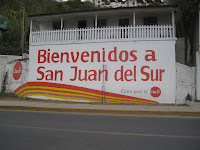I land in Managua, the capital city of Nicaragua, around noon. The drive from the airport to the small village where I will be staying, San Juan del Sur, is a 3 hour trip.
 My driver, Marcos, was a very pleasant man who is often hired by visitors to this village. We stopped almost immediately for some rehydration with coconut water, straight from the fruit of course, and were, shortly thereafter, delayed by a herd of cattle crossing the highway.
My driver, Marcos, was a very pleasant man who is often hired by visitors to this village. We stopped almost immediately for some rehydration with coconut water, straight from the fruit of course, and were, shortly thereafter, delayed by a herd of cattle crossing the highway. The soundtrack to our journey was a CD of what sounded like old polyphonic ringtone versions of classics like “Red, Red Wine,” the “Mission Impossible Theme Song,” and Britney Spears’ “Hit Me Baby One More Time.” We chatted about a variety of subjects along the way, while narrowly avoiding at least two dozen auto accidents. We covered the helmet laws in Nicaragua, and most people’s choice to completely ignore them, the tourist spots where foreigners frequent, the volcanoes in the area and the local agriculture, among others.
The car ride is making me realize that my Spanish isn’t as horrible as I was worried it would be, but I still have a LONG way to go. We stop for pastries and to fill the gas tank at a Texaco station.
Marcos recommends a local fast food joint in the neighboring town of Rivas, with the best fried chicken you will find here. I say I’ll have to try it, though I won’t be able to since giving up meat for Lent! Not too worried though, for peces y mariscos (fish and shrimp) apparently there is no place better than San Juan del Sur!
I arrive in SJDS at about 15:00 local time and to la casa de Doña Salvadora, a cute little green house also next to a Texaco station. I am greeted by her sister, two small children and a chihuahua puppy and shown to my room.
It’s VERY hot here. It is the end of the summer and the rainy winter season will begin in a few weeks. Everything now is very dry. There is no AC, but I have my own room and private bath, even though the water has to be turned on by hand at the tank outside before it can be used!
A lizard just crawled across my wall.
¡Me voy a andar ahora! ¡Hasta luego!


































